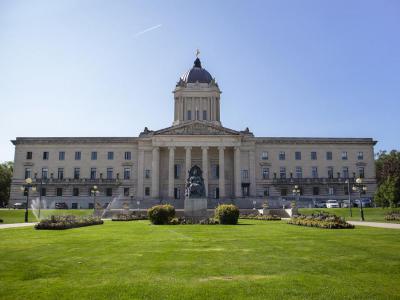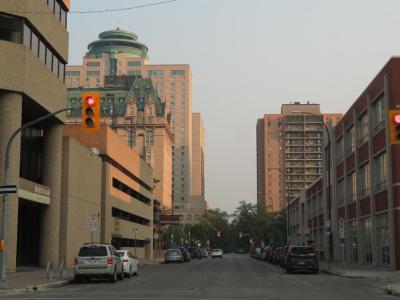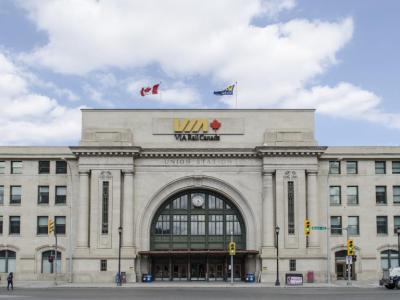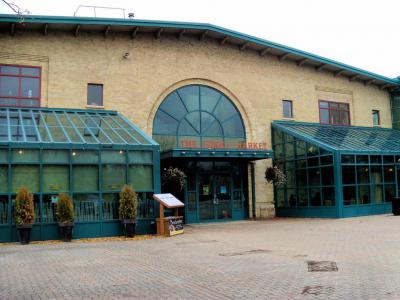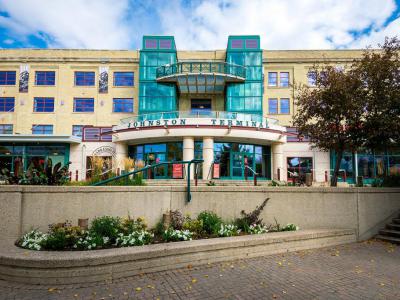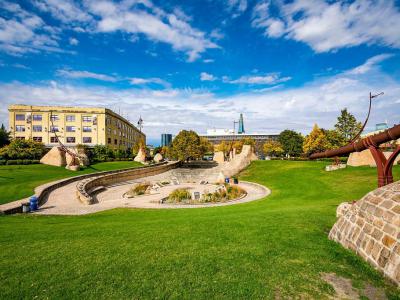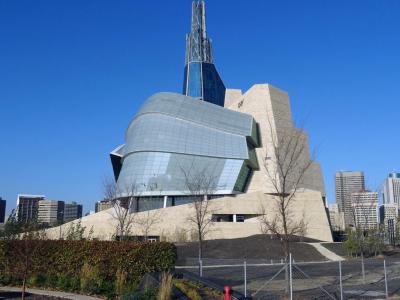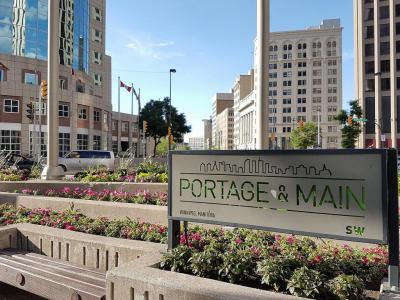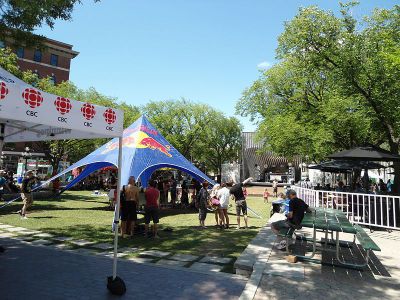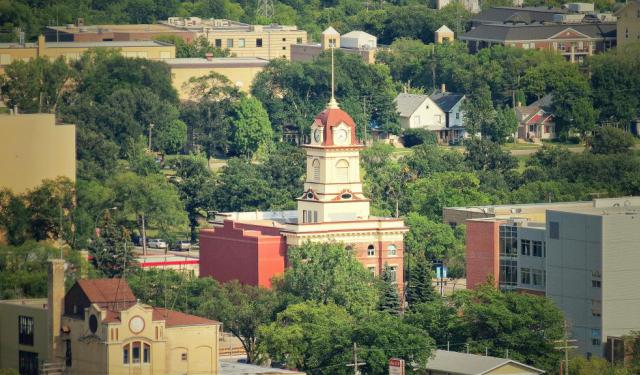Winnipeg Introduction Walking Tour (Self Guided), Winnipeg
Winnipeg (or simply "The Peg", as the locals colloquially shorten it) is the capital city of the Canadian province of Manitoba. The latter is often lovingly referred to as "Friendly Manitoba" for the region's people's friendly vibe. As for the city's name "Winnipeg", it came from the nearby Lake Winnipeg, whose own name, in turn, is derived from the Cree word "wīnipēk," which means "muddy waters."
The area's history dates back thousands of years. Originally, it was inhabited by Indigenous peoples, such as the Cree, Ojibwe, and Assiniboine. European exploration of the region began in the 18th century when French fur traders arrived. In the early 19th century, the Hudson's Bay Company established a trading post, known as "Fort Garry", near the present-day downtown area.
The city experienced rapid growth in the late 19th century due to the development of the Canadian Pacific Railway, which linked the East Coast to the western territories. Strategically located at the confluence of the Red and Assiniboine Rivers – historically regarded as an entry point to the western regions of the country, – Winnipeg became a major transportation hub and a center for agriculture, manufacturing, and finance, ultimately earning the nickname "The Gateway to the West."
A historic place marking the confluence of the Red and Assiniboine Rivers, at the heart of the city, is called The Forks. Today, this site features warehouses turned into shops and restaurants, as well as a vast green space that often hosts festivals, concerts, and various shows. Located inside The Forks, the Canadian Museum for Human Rights uniquely explores the subject of human rights through engaging exhibits and multimedia presentations.
The Manitoba Legislative Building, situated downtown, is an impressive architectural landmark. Built in the early 20th century, it features the Golden Boy, a statue perched atop its dome, and beautiful grounds.
Widely reputed for its frigid climate, Winnipeg is accustomed to banters like "Winterpeg" or "Winnipeg: Where the sun spends the winter", humorously referring to its long and cold winters. Still, those familiar with Winnipeg's diversity and vibrant cultural scene tend to call it "One great city under the sun". To see which of these monikers and expressions hold true from your perspective and to explore the city's main attractions, embark on this self-guided introductory tour.
The area's history dates back thousands of years. Originally, it was inhabited by Indigenous peoples, such as the Cree, Ojibwe, and Assiniboine. European exploration of the region began in the 18th century when French fur traders arrived. In the early 19th century, the Hudson's Bay Company established a trading post, known as "Fort Garry", near the present-day downtown area.
The city experienced rapid growth in the late 19th century due to the development of the Canadian Pacific Railway, which linked the East Coast to the western territories. Strategically located at the confluence of the Red and Assiniboine Rivers – historically regarded as an entry point to the western regions of the country, – Winnipeg became a major transportation hub and a center for agriculture, manufacturing, and finance, ultimately earning the nickname "The Gateway to the West."
A historic place marking the confluence of the Red and Assiniboine Rivers, at the heart of the city, is called The Forks. Today, this site features warehouses turned into shops and restaurants, as well as a vast green space that often hosts festivals, concerts, and various shows. Located inside The Forks, the Canadian Museum for Human Rights uniquely explores the subject of human rights through engaging exhibits and multimedia presentations.
The Manitoba Legislative Building, situated downtown, is an impressive architectural landmark. Built in the early 20th century, it features the Golden Boy, a statue perched atop its dome, and beautiful grounds.
Widely reputed for its frigid climate, Winnipeg is accustomed to banters like "Winterpeg" or "Winnipeg: Where the sun spends the winter", humorously referring to its long and cold winters. Still, those familiar with Winnipeg's diversity and vibrant cultural scene tend to call it "One great city under the sun". To see which of these monikers and expressions hold true from your perspective and to explore the city's main attractions, embark on this self-guided introductory tour.
How it works: Download the app "GPSmyCity: Walks in 1K+ Cities" from Apple App Store or Google Play Store to your mobile phone or tablet. The app turns your mobile device into a personal tour guide and its built-in GPS navigation functions guide you from one tour stop to next. The app works offline, so no data plan is needed when traveling abroad.
Winnipeg Introduction Walking Tour Map
Guide Name: Winnipeg Introduction Walking Tour
Guide Location: Canada » Winnipeg (See other walking tours in Winnipeg)
Guide Type: Self-guided Walking Tour (Sightseeing)
# of Attractions: 9
Tour Duration: 2 Hour(s)
Travel Distance: 3.3 Km or 2.1 Miles
Author: vickyc
Sight(s) Featured in This Guide:
Guide Location: Canada » Winnipeg (See other walking tours in Winnipeg)
Guide Type: Self-guided Walking Tour (Sightseeing)
# of Attractions: 9
Tour Duration: 2 Hour(s)
Travel Distance: 3.3 Km or 2.1 Miles
Author: vickyc
Sight(s) Featured in This Guide:
- Manitoba Legislative Building
- Broadway
- Union Station
- The Forks Market
- Johnston Terminal
- The Forks
- Canadian Museum for Human Rights
- Portage and Main
- Old Market Square
1) Manitoba Legislative Building (must see)
The Manitoba Legislative Building, originally known as the Manitoba Parliament Building, is a magnificent structure that serves as the meeting place of the Legislative Assembly of Manitoba. Situated in the heart of Winnipeg, it holds the distinction of being the twelfth provincial heritage site of Manitoba. The building not only houses the Legislative Assembly but also provides office space for the Premier of Manitoba, the Lieutenant Governor, and various ministers and deputy ministers of provincial government departments.
Constructed in the Neoclassical Beaux-Arts style, the Manitoba Legislative Building is a testament to architectural grandeur. It was completed in 1920, showcasing a harmonious blend of elegance and historical influences. One of the most iconic features of the building is the renowned Golden Boy, a stunning gold-covered bronze statue perched atop the cupola. Inspired by the Roman god Mercury (known as Hermes in Greek mythology), the Golden Boy stands proudly, symbolizing the spirit of progress and prosperity.
Rising to a height of 77 meters (253 feet), the Manitoba Legislative Building was designed and built by the talented duo of Frank Worthington Simon (1862–1933) and Henry Boddington III. Alongside them, a team of skilled masons and craftsmen contributed their expertise to bring this architectural masterpiece to life. The building's meticulous attention to detail, intricate carvings, and exquisite craftsmanship reflect the dedication and skill of those involved in its construction.
Beyond its political significance, the Manitoba Legislative Building holds cultural and historical importance for the province. Its designation as a provincial heritage site underscores its value as a cherished symbol of Manitoba's rich past and promising future. The building stands as a reminder of the province's growth and progress while honoring its heritage and traditions.
Constructed in the Neoclassical Beaux-Arts style, the Manitoba Legislative Building is a testament to architectural grandeur. It was completed in 1920, showcasing a harmonious blend of elegance and historical influences. One of the most iconic features of the building is the renowned Golden Boy, a stunning gold-covered bronze statue perched atop the cupola. Inspired by the Roman god Mercury (known as Hermes in Greek mythology), the Golden Boy stands proudly, symbolizing the spirit of progress and prosperity.
Rising to a height of 77 meters (253 feet), the Manitoba Legislative Building was designed and built by the talented duo of Frank Worthington Simon (1862–1933) and Henry Boddington III. Alongside them, a team of skilled masons and craftsmen contributed their expertise to bring this architectural masterpiece to life. The building's meticulous attention to detail, intricate carvings, and exquisite craftsmanship reflect the dedication and skill of those involved in its construction.
Beyond its political significance, the Manitoba Legislative Building holds cultural and historical importance for the province. Its designation as a provincial heritage site underscores its value as a cherished symbol of Manitoba's rich past and promising future. The building stands as a reminder of the province's growth and progress while honoring its heritage and traditions.
2) Broadway
Broadway, situated in Winnipeg, is a historic street that holds significance as one of the oldest routes in the city. It serves as a part of the Trans-Canada Highway's path through downtown Winnipeg.
Stretching between Main Street and Osborne Street, Broadway is bordered by the Union Station in the east and the Manitoba Legislative Building in the west. Not only does Broadway have a rich historical background, but it also acts as an informal boundary between the commercial and residential zones in the southern region of downtown.
The eastern section of Broadway boasts a charming ambiance with its wide boulevard adorned with a park-like setting and a canopy of elm trees. This part of the street is home to several of Winnipeg's most ancient structures, such as the Manitoba Legislative Building, Fort Garry Hotel, Provincial Law Courts Building, and numerous other heritage buildings. Due to its location in the southern downtown area, it also acts as a dividing line between the northern commercial development and a residential enclave extending south towards the Assiniboine River.
The Broadway Promenade serves as a pedestrian walkway connecting the Esplanade Riel pedestrian bridge to Union Station and Broadway. The design, created by Scatliff+Miller+Murray, incorporates two pathways that intersect the area. One of these pathways reestablishes the historical connection between Broadway and Provencher Boulevard, while the other represents a meandering route symbolizing the era before European contact.
Stretching between Main Street and Osborne Street, Broadway is bordered by the Union Station in the east and the Manitoba Legislative Building in the west. Not only does Broadway have a rich historical background, but it also acts as an informal boundary between the commercial and residential zones in the southern region of downtown.
The eastern section of Broadway boasts a charming ambiance with its wide boulevard adorned with a park-like setting and a canopy of elm trees. This part of the street is home to several of Winnipeg's most ancient structures, such as the Manitoba Legislative Building, Fort Garry Hotel, Provincial Law Courts Building, and numerous other heritage buildings. Due to its location in the southern downtown area, it also acts as a dividing line between the northern commercial development and a residential enclave extending south towards the Assiniboine River.
The Broadway Promenade serves as a pedestrian walkway connecting the Esplanade Riel pedestrian bridge to Union Station and Broadway. The design, created by Scatliff+Miller+Murray, incorporates two pathways that intersect the area. One of these pathways reestablishes the historical connection between Broadway and Provencher Boulevard, while the other represents a meandering route symbolizing the era before European contact.
3) Union Station
Union Station is a remarkable architectural gem that represents the Beaux-Arts style and holds significant historical significance. Constructed between 1908 and 1911, this grand stone railway terminal stands proudly at the intersection of Main Street and Broadway Avenue in downtown Winnipeg.
The primary elements recognized for their historical value are the railway station building itself, the adjoining passenger tunnel, the platforms, and the train shed. Union Station holds special importance as it served as the terminal for three railway companies and played a crucial role in breaking the monopoly of the Canadian Pacific Railway in the West. The construction of Union Station reflected the confidence of both the railway industry and the city in the rapid growth of the West.
Architecturally, Union Station is considered one of the finest examples of Beaux-Arts-style railway stations in Canada. It adheres to the principles of Beaux-Arts design, evident in its symmetrical arrangement, axial plan, and the use of classical elements on a grand scale. The building harmoniously interacts with its surroundings, demonstrating a consciousness of the physical environment typical of the City Beautiful movement.
The train shed of Union Station boasts eight through tracks and four passenger platforms. It features a variation of the Bush-type shed design by Lincoln Bush. Additionally, two tracks and two platforms within the train shed were home to the Winnipeg Railway Museum. However, according to current plans, the museum will be relocated to another area within the metro to make way for a rapid transit hub station. This hub station will serve as a meeting point for several routes that traverse the city, further enhancing the transportation infrastructure of Winnipeg.
The primary elements recognized for their historical value are the railway station building itself, the adjoining passenger tunnel, the platforms, and the train shed. Union Station holds special importance as it served as the terminal for three railway companies and played a crucial role in breaking the monopoly of the Canadian Pacific Railway in the West. The construction of Union Station reflected the confidence of both the railway industry and the city in the rapid growth of the West.
Architecturally, Union Station is considered one of the finest examples of Beaux-Arts-style railway stations in Canada. It adheres to the principles of Beaux-Arts design, evident in its symmetrical arrangement, axial plan, and the use of classical elements on a grand scale. The building harmoniously interacts with its surroundings, demonstrating a consciousness of the physical environment typical of the City Beautiful movement.
The train shed of Union Station boasts eight through tracks and four passenger platforms. It features a variation of the Bush-type shed design by Lincoln Bush. Additionally, two tracks and two platforms within the train shed were home to the Winnipeg Railway Museum. However, according to current plans, the museum will be relocated to another area within the metro to make way for a rapid transit hub station. This hub station will serve as a meeting point for several routes that traverse the city, further enhancing the transportation infrastructure of Winnipeg.
4) The Forks Market
For thousands of years, The Forks has served as a gathering spot where the Red and Assiniboine Rivers meet. Originally a railyard, The Forks has transformed into Winnipeg's top tourist attraction, drawing over four million visitors each year. Among its main highlights is The Forks Market, a diverse shopping destination that offers a wide range of specialty shops, restaurants, and entertainment options.
The recent redesign of The Forks Market pays homage to its rich history while also embracing its promising future. Inspired by the site's industrial roots as two separate railway stables, the interior of the market's atrium incorporates a unique combination of raw steel, blacksmith craftsmanship, and reclaimed natural wood accents.
Striking metal drum pendants hang above the tables, defining the dining area and providing attractive lighting. The food kiosks have been revamped with versatility in mind, attracting high-quality vendors who offer a variety of cuisine options. Additionally, a new beverage kiosk offers an extensive selection of craft beer and wine that can be sampled or paired with the food offerings.
To maintain The Forks' reputation as a gathering place, the space includes a series of custom-designed small oak tables that can be transformed into a single large harvest table capable of accommodating up to 80 people for larger gatherings and events. The revitalized Forks Market ushers in an exciting new chapter for this beloved meeting spot in Winnipeg.
In recognition of its outstanding interior design, The Forks Market was awarded the grand prize in the 2017 Commerce Design Winnipeg Awards.
The recent redesign of The Forks Market pays homage to its rich history while also embracing its promising future. Inspired by the site's industrial roots as two separate railway stables, the interior of the market's atrium incorporates a unique combination of raw steel, blacksmith craftsmanship, and reclaimed natural wood accents.
Striking metal drum pendants hang above the tables, defining the dining area and providing attractive lighting. The food kiosks have been revamped with versatility in mind, attracting high-quality vendors who offer a variety of cuisine options. Additionally, a new beverage kiosk offers an extensive selection of craft beer and wine that can be sampled or paired with the food offerings.
To maintain The Forks' reputation as a gathering place, the space includes a series of custom-designed small oak tables that can be transformed into a single large harvest table capable of accommodating up to 80 people for larger gatherings and events. The revitalized Forks Market ushers in an exciting new chapter for this beloved meeting spot in Winnipeg.
In recognition of its outstanding interior design, The Forks Market was awarded the grand prize in the 2017 Commerce Design Winnipeg Awards.
5) Johnston Terminal
Johnston Terminal is a historical landmark in Winnipeg situated at The Forks, a renowned tourist destination steeped in history. Constructed in 1929, this four-story Heritage Building has been carefully restored to its former glory in 1993, offering a unique blend of retail and office spaces. With its prime location and rich architectural charm, Johnston Terminal has become a hub of activity and an integral part of The Forks' vibrant atmosphere.
Covering an expansive area of 73,212 square feet, Johnston Terminal houses a diverse range of tenants. The ground floor and second floor of the building are dedicated to retail establishments, featuring popular destinations like the Old Spaghetti Factory and Kite and Kaboodle. These retailers add a delightful touch to the terminal, providing visitors with a variety of shopping and dining options. Whether you're in the mood for a delicious Italian meal or seeking a unique toy or kite, the ground and second floors of Johnston Terminal have something to offer every visitor.
On the upper levels of Johnston Terminal, the third and fourth floors accommodate office tenants. Among the esteemed occupants of these floors are Thinkbox Software Inc., a renowned software company, and the Teachers' Retirement Allowance Fund, a significant organization in the education sector. These office spaces provide a professional and conducive environment for businesses and organizations to thrive, all while enjoying the historical charm and strategic location of Johnston Terminal.
Covering an expansive area of 73,212 square feet, Johnston Terminal houses a diverse range of tenants. The ground floor and second floor of the building are dedicated to retail establishments, featuring popular destinations like the Old Spaghetti Factory and Kite and Kaboodle. These retailers add a delightful touch to the terminal, providing visitors with a variety of shopping and dining options. Whether you're in the mood for a delicious Italian meal or seeking a unique toy or kite, the ground and second floors of Johnston Terminal have something to offer every visitor.
On the upper levels of Johnston Terminal, the third and fourth floors accommodate office tenants. Among the esteemed occupants of these floors are Thinkbox Software Inc., a renowned software company, and the Teachers' Retirement Allowance Fund, a significant organization in the education sector. These office spaces provide a professional and conducive environment for businesses and organizations to thrive, all while enjoying the historical charm and strategic location of Johnston Terminal.
6) The Forks (must see)
The Forks, situated in Downtown Winnipeg, is a remarkable and vibrant site that holds significant cultural and historical importance. Nestled at the confluence of the Red River and Assiniboine River, this iconic location serves as a meeting place, green space, and a hub of activity for both locals and tourists alike.
Throughout its rich history, The Forks has been a gathering spot for various communities. It has witnessed the convergence of early Aboriginal peoples, European fur traders, Métis buffalo hunters, Scottish settlers, riverboat workers, railway pioneers, and countless immigrants. This diverse amalgamation of cultures and backgrounds has contributed to the unique tapestry of The Forks' heritage.
Recognizing its significance, The Forks was designated a National Historic Site of Canada in 1974. It earned this distinction due to its role as a cultural landscape that has witnessed six thousand years of human activity. The site spans 5.5 hectares (14 acres) and remains accessible to the public throughout the year.
In 1989, the Forks National Historic Site was inaugurated, bringing forth an interpretive park that immerses visitors in the area's history and provides valuable insights into the people and events that shaped it. Over time, The Forks has evolved into much more than just a historic site. It has been transformed into a dynamic destination that offers a wide array of attractions and amenities.
The grounds of The Forks now encompass public spaces designed for celebrations and recreational activities. Visitors can explore the revitalized historic buildings that house a vibrant mix of shops and restaurants, offering a delightful blend of local flavors, crafts, and unique experiences. The seamless integration of old and new architecture creates an atmosphere that is both charming and contemporary.
For those seeking more adventurous pursuits, The Forks boasts a skateboard park, catering to enthusiasts of this popular sport. Additionally, the site features a historic port that pays homage to its origins as a vital trading hub.
Throughout its rich history, The Forks has been a gathering spot for various communities. It has witnessed the convergence of early Aboriginal peoples, European fur traders, Métis buffalo hunters, Scottish settlers, riverboat workers, railway pioneers, and countless immigrants. This diverse amalgamation of cultures and backgrounds has contributed to the unique tapestry of The Forks' heritage.
Recognizing its significance, The Forks was designated a National Historic Site of Canada in 1974. It earned this distinction due to its role as a cultural landscape that has witnessed six thousand years of human activity. The site spans 5.5 hectares (14 acres) and remains accessible to the public throughout the year.
In 1989, the Forks National Historic Site was inaugurated, bringing forth an interpretive park that immerses visitors in the area's history and provides valuable insights into the people and events that shaped it. Over time, The Forks has evolved into much more than just a historic site. It has been transformed into a dynamic destination that offers a wide array of attractions and amenities.
The grounds of The Forks now encompass public spaces designed for celebrations and recreational activities. Visitors can explore the revitalized historic buildings that house a vibrant mix of shops and restaurants, offering a delightful blend of local flavors, crafts, and unique experiences. The seamless integration of old and new architecture creates an atmosphere that is both charming and contemporary.
For those seeking more adventurous pursuits, The Forks boasts a skateboard park, catering to enthusiasts of this popular sport. Additionally, the site features a historic port that pays homage to its origins as a vital trading hub.
7) Canadian Museum for Human Rights (must see)
The Canadian Museum for Human Rights, located in Winnipeg, is a remarkable institution dedicated to exploring the subject of human rights with a special focus on Canada. As a national museum and a Crown corporation, it plays a vital role in enhancing public understanding of human rights, promoting respect for others, and fostering reflection and dialogue.
Established in 2008, the Canadian Museum for Human Rights holds the distinction of being the first new national museum created in Canada since 1967. It also stands as the country's first national museum located outside the National Capital Region. On 19th September 2014, the museum proudly held its opening ceremonies, marking an important milestone in Canadian history.
The Friends of the Canadian Museum for Human Rights is the charitable organization entrusted with the responsibility of attracting and maintaining various forms of philanthropic contributions to the museum. Through their efforts, the museum receives valuable support, ensuring its continued success and impact.
Upon entering the museum, visitors find themselves on the ground floor, where orientation and meeting spaces are available, along with a gift shop, a restaurant, and visitor services. From there, visitors embark on a transformative journey through a series of galleries located on different levels. These galleries are connected by dramatic backlit alabaster ramps, creating a visually striking environment. Notable among these spaces is the Hall of Hope, a powerful testament to the resilience and strength of the human spirit.
Within the museum's premises, visitors can also explore the serene and contemplative Garden of Contemplation. This outdoor space features still-water pools punctuated by dramatic black Mongolian basalt, providing an ideal setting for reflection and introspection.
The visitor experience culminates in the awe-inspiring Israel Asper Tower of Hope. Rising 100 meters above the Canadian Museum for Human Rights, this magnificent glass spire offers visitors breathtaking views of downtown Winnipeg. Standing as a symbol of optimism and aspiration, the tower serves as a reminder of the importance of hope in the pursuit of human rights.
Established in 2008, the Canadian Museum for Human Rights holds the distinction of being the first new national museum created in Canada since 1967. It also stands as the country's first national museum located outside the National Capital Region. On 19th September 2014, the museum proudly held its opening ceremonies, marking an important milestone in Canadian history.
The Friends of the Canadian Museum for Human Rights is the charitable organization entrusted with the responsibility of attracting and maintaining various forms of philanthropic contributions to the museum. Through their efforts, the museum receives valuable support, ensuring its continued success and impact.
Upon entering the museum, visitors find themselves on the ground floor, where orientation and meeting spaces are available, along with a gift shop, a restaurant, and visitor services. From there, visitors embark on a transformative journey through a series of galleries located on different levels. These galleries are connected by dramatic backlit alabaster ramps, creating a visually striking environment. Notable among these spaces is the Hall of Hope, a powerful testament to the resilience and strength of the human spirit.
Within the museum's premises, visitors can also explore the serene and contemplative Garden of Contemplation. This outdoor space features still-water pools punctuated by dramatic black Mongolian basalt, providing an ideal setting for reflection and introspection.
The visitor experience culminates in the awe-inspiring Israel Asper Tower of Hope. Rising 100 meters above the Canadian Museum for Human Rights, this magnificent glass spire offers visitors breathtaking views of downtown Winnipeg. Standing as a symbol of optimism and aspiration, the tower serves as a reminder of the importance of hope in the pursuit of human rights.
8) Portage and Main
Portage and Main in downtown Winnipeg is a major intersection where Portage Avenue and Main Street meet. It's called the "crossroads of Canada" due to its central location in the country. The neighborhood around the intersection is called Portage & Main and belongs to the Fort Rouge–East Fort Garry city ward.
Portage and Main serves as a central hub for several of Winnipeg's main transportation routes. It was once the center of the banking industry in Western Canada, and national banks have branches accessible from beneath the intersection. Over the years, the area has also been used as a temporary city square and a gathering place for parades and events, including the Winnipeg General Strike of 1919.
In 1974, Winnipeg created an underground concourse to connect shopping malls below the intersection. Pedestrian crossings at Portage and Main were closed for 40 years, with street works finished around 1978. The concourse now connects via the Winnipeg Skywalk. Notably, the Portage and Main Circus showcase a concrete sculptural wall by Bruce Head.
Portage and Main holds historical significance for Winnipeg. It was the site where Dale Hawerchuk signed his contract with the Winnipeg Jets in 1981 and served as the location for the "Save the Jets" rallies in 1995 and 1996. In 2016, as the expiration of the agreement to close the intersection approached, city officials considered reopening it to pedestrians.
More recently, Portage and Main has become an anchor point for occasional street festivals and the lighting of holiday decorations during the winter season.
Portage and Main serves as a central hub for several of Winnipeg's main transportation routes. It was once the center of the banking industry in Western Canada, and national banks have branches accessible from beneath the intersection. Over the years, the area has also been used as a temporary city square and a gathering place for parades and events, including the Winnipeg General Strike of 1919.
In 1974, Winnipeg created an underground concourse to connect shopping malls below the intersection. Pedestrian crossings at Portage and Main were closed for 40 years, with street works finished around 1978. The concourse now connects via the Winnipeg Skywalk. Notably, the Portage and Main Circus showcase a concrete sculptural wall by Bruce Head.
Portage and Main holds historical significance for Winnipeg. It was the site where Dale Hawerchuk signed his contract with the Winnipeg Jets in 1981 and served as the location for the "Save the Jets" rallies in 1995 and 1996. In 2016, as the expiration of the agreement to close the intersection approached, city officials considered reopening it to pedestrians.
More recently, Portage and Main has become an anchor point for occasional street festivals and the lighting of holiday decorations during the winter season.
9) Old Market Square
Old Market Square, located in Winnipeg, holds a rich history that dates back to 1889 when it was originally established as a public market building. Over the years, this vibrant space has undergone a remarkable transformation and now stands as a hub of cultural and artistic activities.
The new design of Old Market Square showcases a range of features that make it an inviting and versatile venue. Among these are a spacious performance area, a sunken event lawn, a serpentine seating wall, and seating planters encircling elegant elm trees. However, the true centerpiece of the renovation is "The Cube."
"The Cube" is a remarkable architectural marvel that boasts an exterior composed of 20,000 aluminum links. This 28x28-foot (8.5 m) cube features a flexible curtain of diamond extrusions, allowing it to be drawn back to reveal the stage within. The stage is equipped with a built-in lighting system, a green room, and two performance levels, providing artists with an exceptional platform to showcase their talent.
Throughout the year, Old Market Square plays host to a variety of renowned festivals and events. One such event is the Jazz Winnipeg Festival, which brings together local and international jazz musicians for captivating performances. Another highlight is the Winnipeg Fringe Theatre Festival, where theater enthusiasts gather to enjoy an array of thought-provoking and entertaining shows. Additionally, the Manitoba Electronic Music Exhibition adds a contemporary and electronic flair to the vibrant atmosphere of the square.
The new design of Old Market Square showcases a range of features that make it an inviting and versatile venue. Among these are a spacious performance area, a sunken event lawn, a serpentine seating wall, and seating planters encircling elegant elm trees. However, the true centerpiece of the renovation is "The Cube."
"The Cube" is a remarkable architectural marvel that boasts an exterior composed of 20,000 aluminum links. This 28x28-foot (8.5 m) cube features a flexible curtain of diamond extrusions, allowing it to be drawn back to reveal the stage within. The stage is equipped with a built-in lighting system, a green room, and two performance levels, providing artists with an exceptional platform to showcase their talent.
Throughout the year, Old Market Square plays host to a variety of renowned festivals and events. One such event is the Jazz Winnipeg Festival, which brings together local and international jazz musicians for captivating performances. Another highlight is the Winnipeg Fringe Theatre Festival, where theater enthusiasts gather to enjoy an array of thought-provoking and entertaining shows. Additionally, the Manitoba Electronic Music Exhibition adds a contemporary and electronic flair to the vibrant atmosphere of the square.
Walking Tours in Winnipeg, Canada
Create Your Own Walk in Winnipeg
Creating your own self-guided walk in Winnipeg is easy and fun. Choose the city attractions that you want to see and a walk route map will be created just for you. You can even set your hotel as the start point of the walk.
Saint Boniface Walking Tour
"In the heart of Winnipeg, where the river flows and the spirit of voyageurs still dances in the air, the soul of French-Canadian culture beats in Saint Boniface."
Before the European settlers arrived, the area on the east bank of the Red River was inhabited by the indigenous First Nations people. In 1818, a French-Canadian clergyman named Joseph-Norbert Provencher, one of the... view more
Tour Duration: 2 Hour(s)
Travel Distance: 4.6 Km or 2.9 Miles
Before the European settlers arrived, the area on the east bank of the Red River was inhabited by the indigenous First Nations people. In 1818, a French-Canadian clergyman named Joseph-Norbert Provencher, one of the... view more
Tour Duration: 2 Hour(s)
Travel Distance: 4.6 Km or 2.9 Miles
The Most Popular Cities
/ view all



